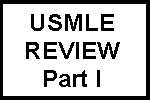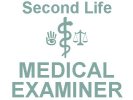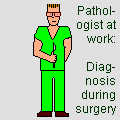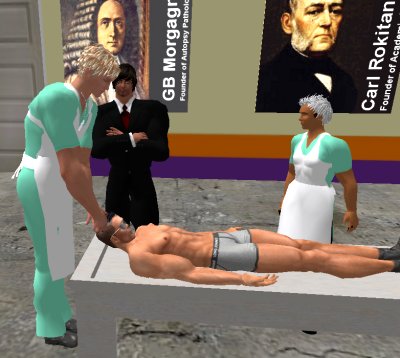Ed Friedlander, M.D., Pathologist
scalpel_blade@yahoo.com
No texting or chat messages, please. Ordinary e-mails are welcome.

|

|
 |
 |
 |
 |
|
verify here. |
Cyberfriends: The help you're looking for is probably here.
This website collects no information. If you e-mail me, neither your e-mail address nor any other information will ever be passed on to any third party, unless required by law.
This page was last modified January 1, 2016.
I have no sponsors and do not host paid advertisements. All external links are provided freely to sites that I believe my visitors will find helpful.
Welcome to Ed's Pathology Notes, placed here originally for the convenience of medical students at my school. You need to check the accuracy of any information, from any source, against other credible sources. I cannot diagnose or treat over the web, I cannot comment on the health care you have already received, and these notes cannot substitute for your own doctor's care. I am good at helping people find resources and answers. If you need me, send me an E-mail at scalpel_blade@yahoo.com Your confidentiality is completely respected. No texting or chat messages, please. Ordinary e-mails are welcome.
 I am active in HealthTap,
which provides free medical guidance from your cell phone.
There is also a fee site at
www.afraidtoask.com.
I am active in HealthTap,
which provides free medical guidance from your cell phone.
There is also a fee site at
www.afraidtoask.com.
 If you have a Second Life account, please visit my teammates and me at the Medical Examiner's office. |

|
 |
With one of four large boxes of "Pathguy" replies. |
 I'm still doing my best to answer
everybody.
Sometimes I get backlogged,
sometimes my E-mail crashes, and sometimes my
literature search software crashes. If you've not heard
from me in a week, post me again. I send my most
challenging questions to the medical student pathology
interest group, minus the name, but with your E-mail
where you can receive a reply.
I'm still doing my best to answer
everybody.
Sometimes I get backlogged,
sometimes my E-mail crashes, and sometimes my
literature search software crashes. If you've not heard
from me in a week, post me again. I send my most
challenging questions to the medical student pathology
interest group, minus the name, but with your E-mail
where you can receive a reply.
Numbers in {curly braces} are from the magnificent Slice of Life videodisk. No medical student should be without access to this wonderful resource.
 I am presently adding clickable links to
images in these notes. Let me know about good online
sources in addition to these:
I am presently adding clickable links to
images in these notes. Let me know about good online
sources in addition to these:
pathology.org -- my cyberfriends, great for current news and browsing for the general public
EnjoyPath -- a great resource for everyone, from beginning medical students to pathologists with years of experience
Medmark Pathology -- massive listing of pathology sites
Estimating the Time of Death -- computer program right on a webpage
Pathology Field Guide -- recognizing anatomic lesions, no pictures
Freely have you received, freely give. -- Matthew 10:8. My site receives an enormous amount of traffic, and I'm still handling dozens of requests for information weekly, all as a public service.
Pathology's modern founder, Rudolf Virchow M.D., left a legacy of realism and social conscience for the discipline. I am a mainstream Christian, a man of science, and a proponent of common sense and common kindness. I am an outspoken enemy of all the make-believe and bunk that interfere with peoples' health, reasonable freedom, and happiness. I talk and write straight, and without apology.
Throughout these notes, I am speaking only for myself, and not for any employer, organization, or associate.
Special thanks to my friend and colleague, Charles Wheeler M.D., pathologist and former Kansas City mayor. Thanks also to the real Patch Adams M.D., who wrote me encouragement when we were both beginning our unusual medical careers.
If you're a private individual who's enjoyed this site, and want to say, "Thank you, Ed!", then what I'd like best is a contribution to the Episcopalian home for abandoned, neglected, and abused kids in Nevada:

My home page
More of my notes
My medical students
Especially if you're looking for information on a disease with a name that you know, here are a couple of great places for you to go right now and use Medline, which will allow you to find every relevant current scientific publication. You owe it to yourself to learn to use this invaluable internet resource. Not only will you find some information immediately, but you'll have references to journal articles that you can obtain by interlibrary loan, plus the names of the world's foremost experts and their institutions.
Alternative (complementary) medicine has made real progress since my generally-unfavorable 1983 review. If you are interested in complementary medicine, then I would urge you to visit my new Alternative Medicine page. If you are looking for something on complementary medicine, please go first to the American Association of Naturopathic Physicians. And for your enjoyment... here are some of my old pathology exams for medical school undergraduates.
I cannot examine every claim that my correspondents
share with me. Sometimes the independent thinkers
prove to be correct, and paradigms shift as a result.
You also know that extraordinary claims require
extraordinary evidence. When a discovery proves to
square with the observable world, scientists make
reputations by confirming it, and corporations
are soon making profits from it. When a
decades-old claim by a "persecuted genius"
finds no acceptance from mainstream science,
it probably failed some basic experimental tests designed
to eliminate self-deception. If you ask me about
something like this, I will simply invite you to
do some tests yourself, perhaps as a high-school
science project. Who knows? Perhaps
it'll be you who makes the next great discovery!
Our world is full of people who have found peace, fulfillment, and friendship
by suspending their own reasoning and
simply accepting a single authority that seems wise and good.
I've learned that they leave the movements when, and only when, they
discover they have been maliciously deceived.
In the meantime, nothing that I can say or do will
convince such people that I am a decent human being. I no longer
answer my crank mail.
This site is my hobby, and I do not accept donations, though I appreciate those who have offered to help.
During the eighteen years my site has been online, it's proved to be one of the most popular of all internet sites for undergraduate physician and allied-health education. It is so well-known that I'm not worried about borrowers. I never refuse requests from colleagues for permission to adapt or duplicate it for their own courses... and many do. So, fellow-teachers, help yourselves. Don't sell it for a profit, don't use it for a bad purpose, and at some time in your course, mention me as author and William Carey as my institution. Drop me a note about your successes. And special thanks to everyone who's helped and encouraged me, and especially the people at William Carey for making it still possible, and my teaching assistants over the years.
Whatever you're looking for on the web, I hope you find it, here or elsewhere. Health and friendship!
![]() KCUMB Students
KCUMB Students
"Big Robbins" -- Cell Injury
Lectures follow Textbook
QUIZBANK:
To paraphrase my favorite philosophy instructor, SUCCESSFUL STUDENTS OF PATHOLOGY ARE SUCCESSFUL, ULTIMATELY, BECAUSE THEY LEARN TO PARTICIPATE IN THE ACTIVITY. Ordering and interpreting lab tests will be, for most of you, your most common "pathology" activity as you practice medicine.
This is also the hardest thing to teach in the classroom. Pathologists themselves agree about this, but can't agree how or when it's best-taught (Am. J. Clin. Path. 100: 594, 1993). Without live patients, it's almost as deadly to teach it as to study it.
WHEN I HAVE MORE TIME ALLOTTED AND HAVE TO TRY TO TEACH LAB MEDICINE IN THE CLASSROOM, I USE A CASE-BY-CASE, SORT-OF-RANDOM ORDER, ACTIVE-LEARNING APPROACH. Not everyone likes this, but it beats "passive learning, follow-the-notes lectures". If you can think of a better way to teach lab use, I'm all ears.
As a lecturer on lab use, I try not to duplicate what you have learned about bug-testing in the "Microbiology-Immunology" course. And the clinical faculty will probably want to tell you about drug-abuse screening, allergy testing, the workup of gut problems (diarrhea, malabsorption), and what to do when we suspect a pulmonary embolus.
As a pocket reference, I recommend BAKERMAN. Lab textbooks for the classroom contradict one another, especially when it comes to screening algorithms (i.e., how much of other people's money do you spend searching for the unlikely). I'M HERE TO TEACH YOU THE WHATS, WHYS, AND HOWS, so that you can make some sense out of the mess.
Most of this unit is a fantasia centered around the "screening tests" and "profiles" that you will order in the hospital and in the clinic. You will learn how and when to order these tests, and the reasons people may have values outside the "normal range" without being sick. You will also review some elementary concepts about lab testing that are often points of confusion.
The classroom isn't the ideal place to learn how to order and interpret lab tests. (See, for example, a discussion of this problem in Am. J. Clin. Path. 100: 594, 1993). But THIS STUFF IS WORTH KNOWING BEFORE YOU GO ON ROTATIONS. For now, hang onto this handout for use during the active-learning time in lab. Hopefully, this isn't all entirely new material.
In 2007, about 6.8 billion clinical lab tests were performed in the US, generating about $52 billion in revenue, which is only 2.3% of health care spending but influences the majority of health care decisions (Am. J. Clin. Path. 138: 347, 2012). The industry is quite efficient (Arch. Path. Lab. Med. 112: 235, 1988; still good), and the DRG guidelines from the 1980's were really quite reasonable. A certain amount of chaos still reigns in the routine ordering of lab tests. But despite what you've heard about "unnecessary testing", estimates from just before managed care judged that only around 20% of tests were superfluous (J. Gen. Int. Med. 5: 335, 1990; Arch. Int. Med. 149: 549, 1989). Yes, you can develop anemia from having too many blood tests, even if you're a grown-up (Crit. Care. Med. 17: 1143, 1989). The worst "unnecessary testing" is probably clinicians re-ordering labs for no real reason (J. Clin. Path. 58: 457, 2005) -- of course, this is from the pathologist's point of view, and perhaps the clinicians suspect lab errors. (Lab errors still happen; most are with specimien collection and delivery -- "preanalytic errors" -- Am. J. Clin. Path. 138: 477, 2012. What was a dream in my school years is now a reality -- to type a patient's ID into a computer, see their full array of completed and pending lab tests, and perhaps even get an interpretation and advice.
STANDARDIZATION of lab testing means that a particular health care system uses the same assay system in all its labs (i.e., the same method of determining hemoglobin A1c). Until we have full HARMONIZATION (i.e., all commercially-available assay systems give exactly the same reuslt),
In the 1980's, it was politically correct to inveigh against laboratory tests for screening. The racket of charging megabucks for "interpreting the chemical profile" has been eliminated by new methods of reimbursement. But perverse incentives remain (see below). The truth is that screening is a good, cheap way to find disease that you can treat and thus help people. Mayo's got 1% or better case-finding from each of the following: lipid profile, chemical profile, urinalysis, CBC, thyroid screen (Am. J. Med. 101: 142, 1997). Also see below.
The hospital laboratory is usually run by pathologists. Most of us enjoy helping medical students and clinicians interpret the welter of data that the lab provides on their patients. In fact, the pathologist's ability to communicate with the clinicians is the most imporant factor in preventing clnician dissatisfaction (Arch. Path. Lab. Med. 130: 645, 2006). Most lab procedures are automated, and visits to the lab are fascinating. (There's a dandy senior pathology elective at UMKC, just down the road. Call 556-3785.) Most physicians routinely discuss lab tests (and most everything else) using jargon names (acronyms, etc.) You will learn these on rotations.
As a clinical student, you will ORDER LAB TESTS under the supervision of the house staff and attending staff on your service. This is easy. YOU write the name of the test(s) you want on the ORDER SHEET in the patient's chart (the same sheet where orders for drugs, treatments, etc., are listed). Your INTERN, RESIDENT, or ATTENDING may need to countersign your order. The WARD CLERK transcribes your order onto a "lab slip" and, if the lab needs to draw blood, sends it to the lab. Next morning (or perhaps sooner) the PHLEBOTOMIST from the lab will come and draw blood, if you want a blood test, or the NURSES will get a urine specimen. (Just who collects what, and when, varies from hospital to hospital. You will have plenty of opportunities to draw blood from your own patients.) Heads up -- unless the lab is trying extra-hard to enforce strict policies, one tube of blood out of 400 will be from the wrong patient (Am. J. Clin. Path. 132: 164, 2009). The MEDICAL TECHNOLOGIST (highly educated and regulated) or the MEDICAL TECHNICIAN (not quite so elite) performs the test. Most routine tests are batched and run in the morning as soon as the phlebotomists are done collecting all the specimens. The lab reports the RESULT, usually on one ply of the lab slip, or perhaps on a computer print-out. The report usually finds its way back to the patient's chart by evening. (If the result is sufficiently abnormal to indicate an immediate threat to life, the lab recognizes a CRITICAL VALUE ("panic value") and will phone the nurse, the resident, or somebody other than the medical student (update on this important area: Arch. Path. Lab. Med. 126: 663 2002; Am. J. Clin. Path. 125: 758, 2006; Am. J. Clin. Path. 128: 604, 2007; Arch. Path. Lab. Med. 131: 1769, 2007). Panic values are now on computer: Arch. Int. Med. 163: 200, 2003; cost is near zero and everybody seems to benefit.) YOU look at the result and decide what it means, because you will be quizzed on it tomorrow!
Today, POINT-OF-CARE testing is becoming more common. These are labs done at the bedside (outpatient clinic, operating suite, home self-monitoring). Changing where the test is done doesn't seem to impact usage much, at least in surgery: Anesth. Analg. 105: 1711, 2007. EKG's and cheap gadgets to determine peak lung outflow (i.e., screening spirometry) have of course been available for decades. Dipsticking urine to search for infection (J. Clin. Path. 58: 951, 2005) and other acute kidney problems is old-hat but still very useful. Glucometers are ubiquitous in today's health care, and it is hard to avoid having a pulse oximeter attached in the hospital -- both were dreams when I was in medical school. Saliva testing for HIV has revolutionized detection. Point-of-care testing for Helicobacter and cholesterol are coming into use. Point-of-care electrolytes (for example, the new i-STAT) still has some problems but seems to be usable (J. Extra Corpor Tech. 40: 57, 2008). Point-of-care creatinine is being introduced (Clin. Chem. Lab. Med. 45: 1536, 2007).
Of course, you remember that PLASMA is all the unformed elements of the blood, examined when the blood has NOT been allowed to clot. SERUM is the liquid that remains AFTER blood has clotted. Notably, healthy serum lacks clotting factors I, II, V, VII, and XIII.
You will order the following tests frequently. (Some may still be part of "routine tests on admission" for "screening" or "baseline". See below.)
COMPLETE BLOOD COUNT (CBC, now performed by machine -- "Coulter counter", etc.).
This includes hemoglobin, hematocrit, red cell count, red cell indices (MCV, MCH, MCHC). (Hemoglobin, red cell count, and MCV are actually measured, the others are calculated.) It also includes a white cell count ("WBC", always) and usually includes platelets. Your lab's machine may also estimate percentages of lymphocytes, granulocytes, monocytes, eosinophils, and basophils, and/or measure the "RDW", Red-cell-volume Distribution Width, a measure of anisocytosis.)
* The Australians experiment with automatic (i.e., computer-generated) ordering of lab tests based on diagnosis: J. Clin. Path. 59: 533, 2006.
COMPLETE BLOOD COUNT WITH DIFFERENTIAL WHITE CELL COUNT (CBC with diff)
This includes everything on your hospital's CBC. It also includes a differential count of 100 (or 200 or more) white cells, normal and abnormal. (This is now usually automated, also.) It also includes short descriptions and semi-quantitation (+ to +++, etc.) of red cell, white cell, and platelet morphology, are included as required.
In a good lab, there's a manual review by a real technician of any out-of-line findings by the automated machine. Around 15% of peripheral smears get a manual review (Arch. Path. Lab. Med. 130: 596, 2006). I used to look at all of these myself each morning and evening. Very seldom would an experienced technician make a mis-call.
ROUTINE CBC:
Depending on your hospital, you will automatically get a "diff" on everybody, on people with abnormal WBC's ("reflex testing"), or on nobody.
CHEMICAL URINALYSIS ("U/A")
This always includes appearance, specific gravity, pH, protein, glucose, ketones, and blood, and may include bilirubin, nitrite, and urobilinogen.
CHEMICAL URINALYSIS PLUS SEDIMENT EXAM
The lab will usually examine the sediment if the chemical urinalysis is abnormal, and will always examine it if you ask. Automated urinalysis: Clin. Lab. Med. 8: 449, 1988.
"Fishbone convention": Here is how you can represent your lab values in a chart (thanks UCSF). USA version -- these vary from nation to nation.


AUTOMATED CHEMICAL PROFILE ("Chemistry 12", "SMA-18", "SMAC", VP, Ektachem 400, Hitachi 737, Technicon Chem 1, etc., etc.).
A battery of tests described below. Unlike the other tests in this section, it will not be available on an emergency basis. (Pediatric hospitals may not have such a battery.)
* Fun read: Doing the i-STAT blood analyzer in space flight. Clin. Chem. 43: 1056, 1997.
ELECTROLYTES ("'lytes", "electric lights", etc.)
This always includes sodium, potassium, chloride, and "total CO2" (which is within a few percent of the real serum bicarbonate ion concentration). It often includes glucose and BUN, and sometimes even creatinine. Appropriate ordering (in the emergency setting): Ann. Emerg. Med. 20: 16, 1991. A portable analyzer that requires only a drop of blood to do the works: Am. J. Clin. Path. 100: 599, 1993.
BLOOD GASES (often performed in a different lab)
This always includes pH, PaCO2, and PaO2. You may also get hemoglobin (measured), oxygen saturation, "total CO2", base excess, and other values.
You can order a huge selection of OTHER TESTS. "Profiles" may exist at your hospital for various organs or problems ("liver profile", "kidney function tests", "lipid screen", "hypothyroid check", etc.) The "serum porcelain" (for "crackpots") is only a legend. Some tests are run only once or twice a week. Most tests are run in a batch at the start of the day. Please don't ask to have a serum protein electrophoresis or a routine autopsy done in the middle of the night. If the hospital lab does not perform a particular test, it will be send to a REFERENCE LAB, usually on a fee basis. (Or a researcher's lab at the med school might do it.) The Lab Director may not approve every exotic test you order.
If a result suggests serious disease, your lab may perform some tests automatically (a REFLEX PROFILE); for example, if a monoclonal spike appears on protein electrophoresis and the patient is not known to the lab, you may get an instant immunofixation to characterize it.
If you order a "STAT" TEST, the lab personnel run your test before continuing work on anything else. You will get your result in minutes. (The lab will probably phone you.) Of course, this is inefficient and overall holds up everybody else (Arch. Path. Lab. Med. 123: 607, 1999; Arch. Path. Lab. Med. 121: 1031, 1997). But in emergency situations, you need to be able to order a "stat" test! Ask yourself (1) Do you suspect the patient has a life-threatening abnormality that requires immediate attention? (2) Do you need the information for a management decision that you will make within the next few hours? Your stat test may be run in the regular lab, or it may be run in a satellite lab ("stat lab", "blood gas-acute care lab", etc.) In many hospitals, you can get a test run sooner than it would otherwise be without having to resort to a "stat". For example, you may be allowed to tell the lab "PRIORITY", "TODAY", "PATIENT IS WAITING," etc. (Especially for monitoring of "peak and trough levels" of therapeutic drugs, you can arrange to have blood drawn at particular times during the day).
The following tests can usually be ordered "stat" without any hassle: blood gases (usually a stat procedure), electrolytes (serum, urine), osmolality, calcium, glucose, blood urea nitrogen (BUN), creatinine, ammonia (maybe), amylase, "ketones" (acetoacetic acid, etc.), urinalysis (chemical, microscopic), CBC, differential white cell count (maybe, if you're an oncologist), platelet count (if not regularly part of CBC), Gram stain and smear for acid-fast bacilli (you may have to do these yourself), blood cultures (if the lab draws these), serum digoxin level, serum levels of various antibiotics and other drugs, PT, PTT, fibrinogen, fibrin degradation products, LDH total (maybe), blood bank (crossmatch, platelets and fresh frozen plasma), cerebrospinal fluid. These tests should always be available on a "same day" basis without your having to resort to a "stat" to get timely results when there is no emergency.
Your office lab may be equipped with at least (1) a desktop blood-cell counter; (2) a desktop chemistry machine; (3) a desktop immunoassay machine. Thankfully, CLIA (the Federal "Clinical Laboratory Improvement Act", which originally was a disaster for common-sense office labs) was modified to waive the stringent guidelines for the simple, routine tests.
If you don't understand the principle of an enzyme-linked immunosorbent assay (ELISA), take a minute and review the biochemistry. You want to know whether a threshold amount of Substance X is present in the plasma / serum. We prepare a surface (perhaps a nylon card or a special plastic well) and bind to it something that will in turn bind Substance X. We add plasma / serum, let Substance X bind if it is present, then rinse everything else off. Now we add something else that binds to Substance X and can make it visible (favorite choices are antibodies bound to peroxidase or biotin). It's easy, convenient and versatile.
Remember that most definitive diagnoses of serious diseases like cancer are made by examining tissue -- CYTOLOGIES, BIOPSIES, or larger SURGICAL SPECIMENS. Before managed care, young doctors were indoctrinated to "do all the non-invasive procedures first." These includes blood and urine tests, cultures, x-ray studies, and so forth, and this helped prolong hospital stays and increase hospital profits. I was glad to see the change. And remember that the single most useful diagnostic procedure is still the history and physical exam.
Worth knowing:
Red-top: Nothing (the plastic one contains silica granules on the walls as a clot activator). The blood will clot, and the serum is separated by centrifugation. Used for most routine chemistries. Nowadays most "red top" tubes are red-and-black "tiger top" "serum separator" top tubes (SST's), with a silicone separator and a clot activator. It's faster and more convenient to get the serum.
Purple-top: EDTA (calcium-chelating anticoagulant) in liquid form. Best for blood cell counting. Be sure to get fill the tube, and invert eight times for proper mixing.
Light-blue top: A measured amount of citrate (calcium-chelating anticoagulant, readily neutralized). We add a bit of adenosine and some other stuff to keep the platelets happy. Best for routine coagulation studies including platelet function tests.
Gray-top: Fluoride-oxalate. Inhibits glycolytic enzymes. Best for glucose and routine toxicology. Great for lithium determinations. But be sure to fill the tube, or the noxious anticoagulant may hemolyze your red cells!
Yellow top: Acid citrate dextrose. Tests that must be kept at room temperature and shipped to a reference lab. PCR's and reference-immunology especially. Some labs favor these for all serology/immunology and hormones.
Light-green top (sometimes green-gray tiger): Lithium heparin anticoagulant. Less popular than the others, for plasma levels in chemistry. If you need a "plasma rhubarb level", this is the one to use.
Gray/yellow "tiger" top: Thrombin. Instant clotting for stats on serum.
* Pale-Yellow top: sodium polyanethiolesulfonate (SPS), removes cationic antibiotics as well as anticoagulating; again, invert to mix. Not much used.
* Tan top: Lead-free glass for lead determinations. The anticoagulant is heparin.
* Navy-blue top: Trace-metal-free.
* Green-gray tiger top: Lithium-heparin plus separator gel. Best for plasma determinations in chemistry.
* Black top: Specially-buffered sodium citrate, supposedly the best for the Westergren sed rate.
The plastic "hemogard" stoppers that seems to be replacing the beloved rubber stoppers differ slightly in color codes... most notably, the rubber red-black tiger-top uses a gold hemogard.
The lab will probably keep a hospitalized patient's blood for 3 days, and an outpatient's blood for 7 days, in case the clinician wants additional tests ("add-on"): Arch. Path. Lab. Med. 131: 1694, 2007.
A healthy person is someone who has not been completely worked up.
The object of screening is to detect unknown, treatable disease without excessive cost of finding and working up, and risk of working up, false-positives. The Democrats, the Republicans, the insurance carrier, the premium payer, the private payer, and the taxpayer are worried about the latter; the patient is worried about the former.
Depending on your hospital, everyone admitted may get some or all of the following tests, which will be called "the routine admitting lab work". The first six usually fall into the domain of the clinical pathologist. These are
after much to-do, a prostate-specific antigen is now routine for older men (old work JAMA 267: 2215 & 2236, 1992; update, including where to place decision levels J. Urol. 177: 499, 2007; it's been difficult to show that this reduces mortality or morbidity Am. Fam. Phys. 57: 1531, April 1998; more favorable article to support screening: Ann. Int. Med. 144: 441, 2006; the case against extensive screening Ann. Int. Med. 144: 438, 2006);
-- (7) TB![]() skin test (for those not known to be positive);
skin test (for those not known to be positive);
-- (8) electrocardiogram (EKG, ECG) ("for baseline");
-- (9) chest x-ray (CXR -- probably not indicated. See NEJM 312: 209, 1985; there's a new push to return to routine chest x-rays to find early cancers in smokers: Chest 112-S4: 216-S, 1997);
--(10) pap smear / liquid cytology / HPV for women
--(11) mammogram for women over age 40 or 50 (many articles; recommendations vary from nation to nation)
--(12) Watch for routine screening (every few years) for low B12 levels. This is long overdue and people are starting to talk about it. Arch. Phys. Med. 86: 150, 2005; Geriatrics 58: 30, 2003.
Politics is certain to determine the status of routine HIV screening; you (the physician) are more likely to be required to submit to screening than is your surgical patient. There are supposedly about 300,000 people in the US who are HIV positive but don't know it (Arch. Int. Med. 162: 887, 2002). Since the first ten years of the epidemic, the rhetoric has shifted from "protecting people's right not to be tested" to "getting people in for voluntary testing" and bewailing the fact that most primary care physicians don't screen people at risk (Am. J. Pub. Health 92: 1784, 2002). Probably you still can't test without the person's consent (even in prisoners: Pub. Health Rev. 116: 520, 2001). In the early 2000's, hospitals serving underclass communities have teams to get inpatients to accept testing (Arch. Int. Med. 162: 887, 2002). Especially, the availability of medications to keep Baby from catching HIV from Mom has made screening important, and even most (not all) ethicists consider that society may require Mom to accept treatment. OraSure has revolutionized HIV testing among the underclass (Am. J. Pub. Health 94:29, 2004), and PCR for the virus testing is (or should be) routine so as not to miss the acute infections (JAMA 288: 216, 2002). With today's easy saliva screening, "consent" is turning into "opt-out" (i.e., you say, "You want the quickie HIV test, don't you?")
Curiously, the "ethicists" are only now starting to notice that we've been testing for drugs of abuse for decades without informed consent (Am. J. Med. 115: 54, 2003); I predict this will go nowhere because people's lives in an emergency setting depend on our being able to get this information without any interference from persons of delicate conscience. (The person screened is still protected by the rules of physician-patient confidentiality and the requirement that if a test is to have a legal impact, it must be confirmed by a separate test using a different chemical principle.)
One of the great landmarks was the 1989 United States Preventive Services Task force (USPSTF; available from William & Wilkins). It changes as the years go by. The USPSTF marches onward, its methods being reviewed here: Ann. Int. Med. 147: 871, 2007. Their main website seems to be down (July 8, 2008). Click here for the pocket guide on preventive services. "Cookbook is better than no book", especially when it comes to screening, the opportunities to waste money and time are enormous, and guidelines cover one's reputation if you did miss something by not ordering an ultra-low-yield test. For an older overview of screening, see JAMA 254: 1480 and 1499, 1985. During the following years, a consensus seems to have been reached that healthy young folks coming in for minor surgeries don't need any labs at all. Application of USPSTF guidelines to the elderly (with "cost-effectiveness" data): J. Fam. Pract. 34: 320, 1992.
Law mandates the screening of newborns for such things-requiring-early-recognition as hemoglobinopathies, phenylketonuria, galactosemia, and congenital hypothyroidism (Arch. Dis. Child. 67: 1073, 1992). Many states also mandate screening for congenital adrenal hyperplasia, biotinidase deficiency (limb paralysis and blindness, controllable by giving biotin), sickle cell disease, G6PD deficiency, homocystinuria, tyrosinemia, Duchenne's, and/or maple-syrup urine disease (progressive brain damage, preventable by limiting intake of branched-chain amino acids). Today's tests are so sensitive (which is good) that there are about 50 false-positives for every case found (Arch. Ped. Adol. Med. 154: 714, 2000). These probably get done automatically. Neonatal screening and the problems caused by false-positives: Clin. Chim. Acta. 315: 99, 2002; Arch. Ped. Adolesc. Med. 154: 714, 2000. You will also screen young kids for lead poisoning (Am. J. Pub. Health 93: 1253, 2003); old lead paint in houses remains a major health threat about which the politicians are doing nothing (contrast the "asbestos in the schools" hoopla of the late 1980's).
Likewise, protocols (or at least recommendations) exist for lab testing as part of pre-natal care -- everything from blood pressure to glucose to illegal drugs (Am. J. Ob-Gyn. 166: 588, 1992) to alpha-fetoprotein to track down neural tube detects (Am. J. Clin. Path. 97: 541, 1992).
Future clinicians take note: Here's a reasonably current list of things that are probably worth doing routinely for ASYMPATOMATIC CLEAN-LIVING GROWN-UPS WITHOUT FAMILY HISTORIES OF ANYTHING ESPECIALLY BAD OR POSSIBLE EXPOSURE TO SLOW-ACTING POISONS. Ask the local USPSTF guru:
When the Joint Commission on Accreditation of Hospitals issued elaborate regulations requiring document of quality control on occult blood testing, physicians simply stopped doing rectals (Ann. Emerg. Med. 51: 197, 2008).
(maybe, see above)
Screening is now in place; you should screen kids if they've ever lived in a house built before 1960, or if you required to do so by the strange politics; remember there's plenty of lead even outside the urban slums: Pediatrics 94: 59, 1994, but the yield in non-slum kids will be very low; remember parents lie about the age of their house (Arch. Ped. Lab. Med. 157: 584, 2003). There is no consensus about when to treat, but it's still good that screening is taking place.
NOTE THAT THIS LIST DOES NOT INCLUDE A WHOLE LOT OF BLOOD WORK! There are additional interventions (including lab tests) that should be routine during pregnancy, and things to do for children.
When we figure out how to treat the thrombophilias, we may screen everybody; right now, there's probably no reason to (Ann. Int. Med. 127: 895, 1997).
Today, almost all adult patients who present diagnostic problems (or who somebody wants "screened") receive an AUTOMATED CHEMICAL PROFILE (a panel of colorimetric assays on the serum done by a machine). These are run every morning (maybe not on weekends). The best-known of the machines include the Technicon SMAC, Eastman-Kodak's Ektachem 400, and the Hitachi 7377.
Tests on the profile will usually include:
Albumin Calcium Inorganic Phosphate Cholesterol Uric Acid Creatinine Bilirubin Alkaline Phosphatase (Alk Phos) Lactate Dehydrogenase (LD, LDH) Aspartate Aminotransferase (AST, SGOT, GOT) |  |
And the profile at your hospital could also include one or more of these:
"Electrolytes": sodium, potassium, chloride, and "total carbon dioxide content." (These are usually run on a different machine that stays up all night.)
The automated chemical profile provides much information at less cost than any individual test. The machine itself costs around $200,000 to purchase and install. Doing each profile, however, costs pennies in reagents, and a dollar or less overall. (For big batches, one 1983 estimate placed the actual cost to the lab at 17 cents per profile.)
Of course, the lab charges a little more because of overhead and to make up the original cost of the machine. In the recent past, clinicians in private practice could gouge the patient $150 or more for "interpreting the profile".) The automated chemistry profile machine has been one of the big money-makers for most hospitals, and it has paid for other services that lose money. And, of course, reducing the ordering of available tests does not result in a linear decrease in the true cost of health care. ("The first one costs a million dollars, and all the rest cost pennies....") See Hum. Pathol. 15: 499, 1984; largely of historical interest now.
The lab has other machines to do individual tests on an emergency basis. These typically involve ready-made packages of reagents that cost a few dollars each.
INDICATIONS for an automated chemistry profile are still "controversial" because of the "expense" and for other reasons. Whenever there is REASON TO SUSPECT SERIOUS DISEASE (even in such a common situation as mild high blood pressure), and BEFORE GENERAL ANESTHESIA, a chemistry profile is usually ordered. ("Before general anesthesia" a history and physical is probably sufficient: Mayo Clin. Proc. 72: 505, 1997). Serial profiles may be used to follow the course of a disease and its response to treatment. (A profile every few days is plenty.) Chemistry profiles may be ordered on ASYMPATOMATIC PEOPLE, nowadays particularly to screen for cholesterol problems. The three most common serious diseases detected by "screening everybody" are (1) HYPERPARATHYROIDISM, (2) HYPERCHOLESTEROLEMIA, and (3) ALCOHOLIC LIVER DISEASE. If you screen a lot of older people, you'll also pick up some cases of (4) ADULT ONSET DIABETES, though these people generally have at least some complaint that warrants screening (obesity, neuropathy, vascular disease, etc., etc.) You'll also pick up a certain number of patients with (5) UNEXPLAINED ELEVATED LIVER ENZYMES ("transaminasitis") which is probably worth working up (most are just drinkers or folks taking ibuprofen or folks with mild NASH/Syndrome X; but you might find something treatable like hepatitis B, hepatitis C, hemochromatosis, autoimmune hepatitis, or Wilson's). It is notoriously impossible to fully rule out Wilson's using any of the common labs (urinary copper is much better than serum ceruloplasmin but still not 100% sensitive): Gastroenterology 113: 350, 1997. I SAY THAT THESE ALONE JUSTIFY WIDESPREAD SCREENING OF "ASYMPATOMATIC ADULTS" USING THE CHEMICAL PROFILER. Not everybody agrees. Pro: J. Gen. Int. Med. 7: 393, 1992; Am. J. Med. 94: 141, 1993 ("$12,000 to find a serious, treatable disease"). Con: Br. J. Gen. Pract. 41: 496, 1991.
The two most common trivial findings are (6) minor permanent elevations of total bilirubin (i.e., "Gilbert's", less often "thal-minor"), and (7) low serum albumin in the chronically sick (why?), which is usually accompanied by low total serum calcium (why?). If you are screening healthy folk, you'll also find (8) plenty of athletes and people doing hard physical labor, who will have elevated creatine kinase. The great drawbacks of mass screening are that data from tests on people without signs or symptoms of systemic disease GENERATES CONFUSION AND ADDITIONAL EXPENSE to the hospital, and a certain perverse incentive...
THINK. Today's health care plans have a good reason to delay the detection of disease, even if this means the patient will go through a period of sickness, suffering, and disability. If you spend a dollar for a serum calcium screen and you detect a parathyroid adenoma, taking it out will cost the plan big money today. If you let the patient become depressed, have a few years of feeling terrible, and pass a few kidney stones "before screening is justified", he or she is likely to be under the care of a different "provider", and somebody else pays. Get it?
My list, a little longer than the NIH's dementia workup. A psychiatrist (or any other physician) should diagnose psychiatric disease without a physical exam and some labs only if the life-history is absolutely classic for some familiar entity. Remember that fibromyalgia is diagnosed on the history and physical exam.
If you have ordered blood tests, the quality of the results depends on your patient and your specimen.
It's your call as to whether your patient needs to FAST long enough for the chylomicrons to be cleared from the blood and for lipid levels to return to baseline (i.e., overnight). Otherwise, the "lipemic" blood will cause inaccuracies in most photometric tests. (This limits the usefulness of routine screenings on elective afternoon admissions.) Some labs notice (and tell you about) a "lipemic" serum, others will miss it. HIGH SERUM TRIGLYCERIDE LEVELS (over 1000 mg/dL) will increase the following values enough to make a difference clinically: hemoglobin, MCH, MCHC; albumin, total protein, fibrinogen, hemoglobin A1c; transaminase enzymes (ALT, AST); bilirubin, calcium, creatinine, glucose, iron, urea. These values will be decreased: amylase, lipase. (The latter's a big deal if you think you patient has hyperlipidemia type I, or "melted strawberry ice cream blood disease".)
If the patient comes to the lab with a FULL STOMACH, of course, you may see true elevated glucose (slightly) and triglycerides (up to several hundred mg/dL) and decreased bilirubin (if anybody cares). If the value for the serum iron is critical to your investigations, your specimen should be fasting, and the patient should have taken no iron supplements for a few days. Serum alkaline phosphatase is increased while food is in the small bowel in patients with blood groups O and B who are secretors. If the patient has been on "CLEAR LIQUIDS" for a few days, bilirubin may go up. You can figure out for yourself the changes seen in dehydration, ketosis, and protein depletion -- you'll become very familiar with these on rotations.
For routine screening (i.e., you're looking for anemia, early kidney troubles, calcium, transaminases, way-out-of-line cholesterol or glucose) fasting isn't critical. Patients may be unwilling to return in the morning just for bloodwork, so you're usually more likely to get what you really need if you order the labs on the spot.
If your patient is ANXIOUS about the needle stick, it will raise serum glucose and catecholamines and sometimes (if hyperventilation occurs) produces alkalosis.
Using a TOURNIQUET to draw blood is often necessary, but causes errors if it is in place for a long time. If there is much fist-clenching, serum lactic acid goes way up, pH goes down, and serum potassium can increase by 1.0 mEq/L (a BIG increase). By causing transudation of water from the vessels to the interstitial fluid, the tourniquet can also cause small elevations of calcium, iron, magnesium, and proteins. (* You don't measure "plasma potassium"; it is normally lower because a certain amount of potassium is released when blood clots.)
A common blunder is drawing a blood sample from a site DOWNSTREAM FROM AN INTRAVENOUS LINE. If (for example) it's infusing "D5", which is 5% dextrose (glucose) in water, your patient will appear to have a very-high blood glucose and low everything else (Karen Carpenter).
If the blood specimen undergoes HEMOLYSIS as a result of clumsy phlebotomy, too narrow a needle, or on the way to the lab (being placed on top of the radiator, in the freezer, dropped, shaken, sipped, etc., etc.), RESULTING ERRORS CAN BE VERY SERIOUS. Serum magnesium, phosphate, potassium, and some enzymes (LD, AST, acid phosphatase) are greatly increased. LD-1 may be higher than LD-2 ("flip"). (Serum iron will not be significantly increased.) There will also be minor changes in other results, but the false high potassium can result in lethal errors. Serum will be visibly pink when enough hemolysis has occurred to elevate serum potassium 0.1 mEq/L. However, the lab may not notice this.
When blood CLOTS (remember the automated chemistry profile is run on serum), potassium is released from platelets, elevating the value by around 0.5 mEq/L. This is taken into account in calculating the reference range. If, however, the serum stays IN CONTACT WITH THE CLOT for a long while, it will result in inaccurately high iron, LD, and potassium (leaking, mild hemolysis), and falsely lowered glucose (used as energy source by red cells). This is only a problem if the specimen sits around for several hours. The silicone separators help with this. A specimen left on top of a radiator has extremely high LD, phosphate, and potassium, and zero glucose, and this pattern is familiar to every lab worker.
TINY CLOTS (inadequate mixing) or COLD AGGLUTININS (IgM's that bind RBC's to one another below body temperature) in specimens submitted to hematology will result in an increased measured MCV (and decreased calculated RBC -- "uh oh, instant pernicious anemia").
If your patient has recently had a RADIOACTIVE ISOTOPE SCAN, the results of radioimmunoassays will probably be inaccurate. Thankfully, radioimmunoassays are now uncommon (one more dream from my medical school days that's now come true.) Check with the lab.
Even if you manage to avoid any cause of analytic inaccuracy, you must consider your patient's level of activity while interpreting your results. Values obtained in patients who have been SUPINE for a while tend to be lower than in patients who were STANDING UP. (Do you know why?) How much are things diluted? TEN PERCENT: most proteins and non-protein hormones (the ones that are protein-bound); FIVE PERCENT: cholesterol, triglycerides; TWO PERCENT: hemoglobin-hematocrit; NO CHANGE: electrolytes. Also remember: standing up is the cause of orthostatic proteinuria, the commonest reason for excess protein in the urine in outpatient practice.
CHILDHOOD: At birth, HEMOGLOBIN is around 19 mg/dL and MCV around 105 fL. (Both are probably higher than yours -- why might this be?) A few nucleated reds are normal in a newborn's blood. These parameters drop off to lows of about 11 mg/dL and 78 fL at one year, then gradually increase to adult values by puberty. The absolute counts of WHITE CELLS vary depending on age. At birth, all normal white cells are increased 2-4x the normal adult value. Bands and segs peak during the first day, then drop off. Segs are lower than adult values during the first year of life, and the count gradually increases over the following years. The other cell types diminish to near-adult values around age 6. ALKALINE PHOSPHATASE is 2-5x normal (growing bones), dropping to adult levels when bone growth stops after adolescence. Cholesterol levels in healthy children are of course low. Alpha-1 protease inhibitor levels are usually low ("uh-oh, instant emphysema"), and angiotensin converting enzyme levels are generally high ("uh-oh, instant sarcoidosis").
MENSTRUATION: Remember that the PLATELET COUNT may drop by 50% during a normal period.
PREGNANCY: "Anemia of pregnancy" is usual, but HEMOGLOBIN should not go below 10 gm/dL. There is always hemodilution, but more severe anemia suggests iron deficiency and/or folate deficiency. BICARB goes down as women perhaps breathe a bit deeper and more rapidly in later pregnancy. GLUCOSE TOLERANCE decreases. Most serum proteins change as in the ACUTE PHASE REACTION ("stress of being pregnant"). However, SERUM TRANSFERRIN INCREASES (and serum iron decreases, of course). SERUM ALKALINE PHOSPHATASE increases as the placenta grows (2-3x normal). GRANULOCYTOSIS develops before and during labor.
OLD AGE: ALKALINE PHOSPHATASE increases (more in women at and after menopause), often to several times the "upper limit of normal", without any disease. Cholesterol levels average higher than in young adults. The other "routine" chemistry and hematology values do not change significantly in "healthy old age". Various antibodies, including rheumatoid factor, anti-nuclear antibodies, and some syphilis antibodies, may appear without there being disease.
RUNNERS AND OTHER TRAINED ATHLETES show a characteristic pattern of changes. (See Mayo Clin. Proc. 55: 113, 1980) (1) increased plasma volume with decreased Hgb, Hct ("jogger's anemia", still a little bit mysterious); (2) increased reticulocytes (hemolysis due to pavement pounding); (3) increased high-density lipoprotein ("HDL-c", the "good" cholesterol), and decreased low-density lipoprotein ("LDL-c", the "bad" cholesterol); (4) increased creatine kinase (CK, CPK) with up to 15% MB fraction (the "myocardial damage" fraction)... after a marathon, the majority of athletes have CK-MB, troponin T (TnT), BNP or NT-proBNP (heart-failure markers of course, now conveniently available at point of care; remember that a distended right atrium from kidney failure will increase them as well; they are released in equimolar amounts; BNP is clearned in a variety of tissues while NP-proBNP is cleared only by the kidney), myoglobin, and myeloperoxidase in the "heart attack" range (Am. J. Clin. Path. 126: 888, 2006); (5) Increased AST (hepatic ischemia, after marathons. See JAMA 252: 626, 1984). No labs are useful in screening for sports participation (J. Fam. Pract. 52: 127, 2003; interesting paper that matches the way I've always done and taught it).
ESTROGEN USERS (oral contraceptive pill, etc.) exhibit a characteristic group of changes: (1) increased thyroxine, decreased T3RU (increased thyroid-binding globulin); (2) increased cortisol (because of increased cortisol-binding globulin); (3) decreased antithrombin III (remember these people may get thrombosis); (4) increased ceruloplasmin, sometimes increased GGTP; (5) increased triglycerides (maybe)
|
Better to sleep with a sober cannibal than with a drunken ....
|  |
ALCOHOLICS AND OTHER HEAVY DRINKERS present many problems. Every clinician would like to have a simple test to identify problem drinkers accurately. You know the CAGE questions:
C: Have you tried to Cut down drinking?
A: Are you Annoyed by others' concern about your drinking?
G: Have you felt Guilty about drinking?
E: Have you use alcohol as an Eye-opener?
There are others (Arch. Int. Med. 155: 1726, 1995). To start off, look for tolerance. Anyone who isn't obviously drunk with a blood ethanol of 0.15% drinks often and heavily enough to have a tolerance. The same is true for anyone who is walking (driving, etc.) with a blood ethanol of 0.3% (these people are supposed to be more-or-less dead). In the North, I was taught that people who identify themselves as "moderate drinkers" are all chronic heavy drinkers. A serum AST greater than serum ALT, in an otherwise healthy person, suggests heavy drinking. HIGH MCV, high serum uric acid, low serum phosphate, high triglyceride (after parties, in "type IV" patients), and high alkaline phosphatase all have been examined by hopeful laboratorians as signs of habitual drunkenness. (History of trauma helps too, see Ann. Int. Med. 101: 847, 1984.) The most enthusiasm in recent years has been over GAMMA-GLUTAMYL TRANSFERASE (transpeptidase, etc.), elevation of which is common in heavy drinkers (30-80%, often the only abnormality on a profile.) Of course, the same picture can be seen in mild pancreatitis, liver problems (including CHF), phenytoin therapy, estrogen therapy, rheumatoid arthritis, a wide variety of cancer-related problems, and probably others. (See Br. Med. J. 286: 531, 1983.) However, most of the above are easy to rule out, and GGT is fairly well established as a means of following compliance with therapy in many alcoholic treatment programs. (GGT update: Br. Med. J. 302: 388, 1991; heads up, African-Americans normally have twice the levels of other folks). Some labs can measure the ACETALDEHYDE-INDUCED HEMOGLOBIN FRACTION (HgbA1ach), a marker for how much alcohol one has drunk in the last few weeks (Arch. Path. Lab. Med. 116: 924, 1992 -- never became mainstream). CARBOHYDRATED DEFICIENT TRANSFERRIN (CDT test) is now a (fad?) assay to screen for alcohol abuse and test one's abstinence (Clin. Chem. 39: 866, 2001). It is also likely to be up if is there is already advanced liver disease (Alcoholism 25: 1729, 2001), in women losing weight (Alcohol and Alcoholism 36: 603, 2001), and in many others.
DIURETIC ABUSERS AND LAXATIVE ABUSERS exhibit decreased serum sodium, potassium, total CO2, magnesium, and increased chloride (why?). The low potassium can be very unhealthy.
ANOREXIA NERVOSA TYPES (including "flippers") show surprisingly normal lab tests. Endocrine testing may reveal diminished (but not absent) pituitary response to stimulation testing, which compounds confusion with Simmonds's disease.
ANABOLIC STEROID ABUSERS ("breakfast of champions") also exhibit a characteristic group of changes: (1) Increased serum creatinine (increased muscle mass); (2) increased LDL-c cholesterol, and decreased HDL-c cholesterol (see JAMA 252: 507, 1984); (3) increased hemoglobin and hematocrit; (4) increased direct bilirubin (cholestasis), and sometimes increased alkaline phosphatase; (5) decreased thyroxine, increased T3RU (decreased thyroid-binding globulin); (6) decreased serum phosphate for some reason.
PHYSICAL EXAMINATION: Some authorities claim that vigorous prostate massage causes mild (2x normal) increase in serum acid phosphatase and/or prostate-specific antigen for a day or so. (Why?) The changes seem real, but aren't going to mislead any clinical decision-maker (JAMA 267: 2227, 1992).
INTRAMUSCULAR INJECTIONS: Remember these will raise serum skeletal muscle enzymes. (Why?)
DRUGS: Remember that drugs can affect lab tests in two different ways.
1. The drug may act as an interfering substance in the assay ("METHODOLOGIC INTERFERENCES"). For example: (a) vitamin C in high doses causes false negative urine tests for glucose and blood; (b) tetracyclines, being fluorescent, cause false positive fluorescence tests for porphyrins and catecholamines; (c) tolbutamide, erythromycin, and several others cause false increases in transaminases when colorimetric methods are used; (d) bromide ion is measured as chloride by most electrodes. And so forth.
2. The drug may TRULY CHANGE THE PHSYIOLOGIC PARAMETER being measured. For example, (a) spironolactone decreases serum sodium; (b glucocorticoids should suppress ACTH production and raise blood glucose; (c) methyldopa often causes antibodies to bind to RBC's, making them "Coombs positive"; (d) procainamide often causes a "lupus-like" syndrome, with positive anti-nuclear antibodies; (e) gold injected for rheumatoid arthritis can cause proteinuria; (f) a wide range of drugs can cause decreased platelets and/or neutrophils. These are not "artifacts", they are real.
Several of the tests on the chemical profile are enzyme assays. When cells are damaged (not necessarily irreversibly), they may lose some of their contents into the bloodstream. Often these contents include the intracellular enzymes that make up the machinery of the cytoplasm. (Or very active cells release extra enzyme). If serum levels of a particular enzyme activity are elevated above normal, it commonly indicates injury to the cells, and the species of enzyme increased in the serum indicate what organ is damaged.
The ENZYME ACTIVITIES are assayed rather than the enzyme proteins themselves. (Some newer techniques, such as "prostatic acid phosphatase", measure a specific protein by immunologic techniques. This does not necessarily make the test more useful clinically.) Enzyme activities are measured in units of activity, defined differently for different enzymes. (The enzymes themselves would probably be measured in ng/dL.) An "International Unit" (U, IU) of an enzyme is the amount that catalyzes the conversion of 1 micromole of substrate per minute under the defined conditions of the test (temperature, pH, substrate concentration, etc.) Speaking of units, an attempt was made to get all clinical labs and journals to switch to the SI (International System) standard and report everything in terms of kilograms, meters, and seconds, beginning July 1, 1988. (KCUMB students: You'll notice this in the Mass General cases from this era.) There was no good reason to shove it onto clinicians or laboratorians, they resented it, and the attempt was a predictable, total failure (NEJM 327: 49, 1992).
If your tube of blood must wait for two or more hours before being assayed, put it on ice.
You will need to learn these enzymes, which are found in several different tissues, because they are commonly measured by the clinical lab.
ALKALINE PHOSPHATASE (alk phos): bone (osteoblastic activity), intestine (secretors with blood types O or B, or after a fatty meal), liver (especially obstructive-metastatic disease), placenta, some cancers ("Regan" isoenzyme).
The serum levels of three enzymes correlate with hepatic alkaline phosphatase: 5'-NUCLEOTIDASE (5'-NT, 5'-N), GAMMA-GLUTAMYL TRANSPEPTIDASE (GGTP, GGT), and LEUCINE AMINOPEPTIDASE (LAP). Checking one or more of these can clarify the origin of an elevated alkaline phosphate.
AMYLASE (alpha amylase): pancreas, salivary gland, and (to a much lesser extent) many other organs
ASPARTATE AMINOTRANSFERASE (AST, SGOT, GOT): heart, liver (especially hepatocellular disease), red cells, skeletal muscle
LACTATE DEHYDROGENASE: most organs, especially heart, liver, lung, kidney, red cells, skeletal muscle, many cancers
ISOENZYMES are variant forms of enzymes found in different tissues. They do the same things, but they may be composed of different subunits or be entirely different proteins. Knowing which isoenzyme is elevated will often tell which of several tissues has been damaged.
LDH 1: KNOW: Heart, kidney, red cells and their precursors (very sensitive to mild hemolysis during or after sample collection), seminoma
LDH 2:
LDH 3: KNOW: Lung, lymphocytes, platelets
LDH 4: (some acute lymphoblastic leukemias produce a lot of this)
LDH 5: KNOW: Liver, skeletal muscle, neutrophils, prostate
LDH isoenzymes are fast receding into medical history. But they were fun.
INDICATIONS for serum calcium include suspicion of cancer, symptoms or signs of hyperparathyroidism (kidney stones, psychiatric problems, many others), bone diseases, unexplained seizures (especially in babies) or coma, after thyroid or parathyroid surgery, or in other patients at special risk (see below).
The lab measures TOTAL CALCIUM, i.e., ionized plus un-ionized. Only about half the calcium in the serum is the physiologically active IONIZED CALCIUM. The rest is bound to albumin and other proteins, and protons compete for binding sites. The fraction of serum calcium that is ionized varies with pH, because protons compete with calcium to bind to albumin. A decrease of 0.1 pH unit increases the ionized fraction of calcium by about 2%, so the effect is not very marked. However, the fraction of serum calcium that is ionized also varies with the serum albumin level. A decrease of 1 gm/dL in albumin decreases both un-ionized and total calcium by about 0.8 mg/dL. This is important.
The lab does not report ionized calcium (even though that is what you are really worried about) because measuring this requires special techniques for blood collection, a calcium-specific electrode, and other resources. Around normal pH, several formulas have been devised to estimate ionized calcium. For example:
Or, at a glance:
Ionized Cac++ (mg/dL) ~ Total Ca (mg/dL) - albumin (g/dL)
Many interesting laboratory procedures have been devised to distinguish hyperparathyroidism from other causes of hypercalcemia. You will learn about electrolyte equations, serum parathyroid levels, urinary cyclic AMP, tubular resorption of phosphate ("TRP"), etc., etc., on rotations. Nowadays almost everybody uses serum parathormone determinations.
Increased serum magnesium is usually due to renal failure (or to hemolysis of the specimen). Decreased serum magnesium is a subject of occasional current interest, and is thought to be widespread among the sick.
This will get you started....
"Anemia of chronic disease": Low serum iron, low serum iron-binding capacity, normal or high serum ferritin
Iron overload: High serum iron, Fe/TIBC>60% or so, high serum ferritin
Although iron deficiency classically gives a microcytic anemia, a majority of patients have relatively mild deficiency and thus have a normocytic anemia. Unless MCV is 95 fL or above, consider iron studies in the presence of anemia; unless your lab gave you a free serum iron and iron-bineing capacity, start with serum ferritin.
Making sense out of this:
1. In iron deficiency, the capacity of the serum to bind iron increases "in the hopes of snarfing up more iron".
2. In anemia of chronic disease (i.e., prolonged interleukin 1 release making it difficult to transfer iron from the bone marrow macrophages to the normoblasts), interleukin effect also causes lowered TIBC (like albumin, a protein that goes down in the acute phase reaction).
3. Transferrin saturation (i.e., Fe/TIBC) of >60% is suspicious for iron overload, and >80% is extremely suspicious. Remember that transferrin levels drop during the acute phase reaction.
4. Of course, if your patient just took a handful of "multiple vitamins with iron" prior to visiting you, interpretation is clouded....
5. If serum ferritin is less than 30, iron deficiency is present; if more than 100, iron deficiency is not present. Serum ferritin shouldn't be more than 300 ng/mL in a man, or 200 ng/dL in a woman. Levels closely parallel total body iron stores; the fact that serum ferritin rises somewhat in the acute phase reaction is unlikely to cause trouble when the labs are matched with the clinical picture.
Caveat: Many allied health professionals use "iron" as a synonym for blood hemoglobin content. I've given up arguing.... As noted, if you're really concerned about iron, draw a fasting specimen.
*There's a circadian rhythm to serum iron but it's slight and shouldn't matter: Am. J. Clin. Path. 117: 802, 2002.
You'll learn the protocol for the workup of suspected myocardial infarct on rotations. Criteria underwent major changes in 2001 (Am. Heart J. 144: 957, 2001). The troponins (your choice of I or T) rise by six hours ("the gold standard"; they may be up earlier) and stay up for maybe 2-4 days. Most clinicians seem to prefer these. Draw your levels every six hours (NEJM 330: 670, 1994, still good, cardiac troponin cTnT and cTnI) are what we use today. Regrettably, the troponins are measured by a variety of assays, each of which has a different "cut-off" and these vary greatly from system to system; the good news is that most people's baseline troponin is zero (everybody has some CK-MB in the blood). Creatine kinase MB band starts to rise a little sooner and stays up for 1-2 days or so. Both peaks will go higher and vanish sooner if there is reperfusion. The same is true for the troponins.
Troponin I or troponin T is your best enzyme because of tissue specificity. However, despite their being ballyhooed as "totally specific for heart", we know they're not. Infamously, people with chronic myopathies but who are otherwise healthy tend to have elevated troponin T in the heart-attak range (J. Am. Coll. Card. 58: 1819, 2011). SGOT and LDH determinations to detect myocardial infarction are now only of historical interest.
Creatine kinase levels rise following heavy exercise and can stay way up for days. A few % MB band is commonplace, especially after a heavy workout or heavy-duty muscle injury (i.e., surgery). Intramuscular injections can bring a couch potato's creatine kinase to the upper limit of normal. An MB band of maybe 15% of the total CK is pretty suggestive of myocardial injury. The band should disappear 18 hours after heart surgery; of course there will also be a band after cardioversion.
* A host of other markers for heart attack are under investigation. "Ischemia-modified albumin" increases after six minutes or so of real ischemia anywhere in the body -- the test is arcane, and of course if you exercise enough to make yourself breathe harder, or are shocky or have necrotic tumor or what-have-you, you'll come up positive. Simply finding elevated levels of myeloperoxidase in the plasma suggests there's an unstable plaque somewhere -- these tend to loaded with neutrophils so this is no surprise, but whether this information is of any value is for you to decide.
Don't expect to see elevated CK-BB in brain injury (it may not cross the blood-brain barrier, or be present in large enough amounts, or whatever).
Of course, you will continue to look for the requisite Q-waves and/or ST-segment elevation on EGK, decreased wall motion on echocardiography, and hypoperfusion on scan. Remember the latter two are only about 50% specific; scar also doesn't take up tracer or move on echo.
The new, very-sensitive troponin picks up people with coronary insufficiency who are likely to go on to get angina and/or CHF: NEJM 361: 2538, 2009.
We await with interest the entry of galectin-3 (is this severe acute / chronic congestive heart failure?) into the diagnostic panels.
In the old days "Serology" meant a syphilis![]() test. Today, the serology lab does most of the
procedures involving immunology. There is no need for you to know about the technical aspects of
these tests.
test. Today, the serology lab does most of the
procedures involving immunology. There is no need for you to know about the technical aspects of
these tests.
The TITER of a substance measured in the serology lab is the maximum dilution (of a series of dilutions) at which the substance can be detected. Thus a titer of 1:2 or 1:10 is a "low titer" and indicates that not very much of the substance is present. And a titer of 1:128000 is probably a "high titer". Depending on what you are measuring, a titer of 1:100 might be "high" or "low".
"A significant rise in titer" suggests a recent infectious disease. (Why?) "Significant" is usually considered to be a "fourfold rise". If a titer rises from 1:16 to 1:64 during an episode of acute illness, or when a titer rises from 1:10000 to 1:80000, the patient probably had the acute disease to match.
For infectious diseases, the presence of IgM against the pathogen usually indicates acute infection. IgG titers from past infection may disappear slowly or persist for life, depending on the person and the illness.
This isn't the place to talk about syphilis testing. Worth remembering:
You'll confirm your positive screen with a treponemal test. The TP-PA gelatin-based microagglutination test is replacing the classic immunofluorescence-microscopy FTA-ABS, which supposedly eliminates the few false-positives, and is usually positive in primary and almost always positive in tertiary syphilis.
The standard treatment for syphilis doesn't cure neurosyphilis. The classic teaching is that you need to do a lumbar puncture if you suspect neurosyphilis in order to treat it properly. Exactly what the serologies on spinal fluid mean is still under discussion (it's still confusing), and no one has explained to me why treating presumptively for neurosyphilis is less benign than a lumbar puncture. Stay tuned.
Effusions are ultra-filtrates of plasma in the pleural, pericardial, or peritoneal cavities. These are commonly encountered in sick people. You may remove fluid which has accumulated in a cavity for diagnostic purposes, or to treat the patient (pleural effusions may restrict lung expansion, pericardial effusions may cause tamponade, etc.) Here is one recommended way to submit a sample of the effusion to the lab for study:
LD (LDH; compare with serum values to determine whether the effusion is a transudate or exudate);
GLUCOSE (low in rheumatoid and septic effusions);
TRIGLYCERIDES and CHOLESTEROL (milky effusions);
AMYLASE (acute pancreatitis; remember this can also cause pleural effusions);
* ADENOSINE DEAMINASE, an activated-macrophage / angry-T-cell marker, fairly specific for tuberculosis![]() , but there's not much of this in the US;
, but there's not much of this in the US;
* BILE (bile peritonitis, as from a ruptured gallbladder);
* HYALURONIC ACID (reference lab procedure that may help make the diagnosis of mesothelioma).
TRANSUDATES generally are due to congestive heart failure, hepatic cirrhosis, or the nephrotic syndrome. These effusions typically contain less than 2.5 gm/dL protein, show specific gravity less than 1.015, effusion LD:serum LD less than 0.6. These characteristics must all be present, or the fluid is not a transudate. Transudates fail to clot, and contain fewer than 10 cells/cu mcL (lymphs, mesothelial cells). (These can be true of exudates, too.) If the protein and LD values indicate a transudate, no further tests on the fluid are indicated. (You may discard the other tubes.)
EXUDATES should make you think of cancer or infection (TB, pneumonia, etc.) Less often, exudates are due to trauma, pancreatitis, rheumatoid arthritis, systemic lupus, infarcts (pulmonary, myocardial, etc.), trauma. Exudates contain more protein and LD than transudates, and may even clot. The type of cells in an exudate can help tell its origin. Many POLYS (i.e., a "purulent exudate") of course suggests bacterial infection. BLOODY effusions suggest cancer, infarction, or iatrogenic or other trauma. Perhaps 50% of malignant effusions contain CANCER CELLS. LYMPHOCYTES and MESOTHELIAL CELLS are quite nonspecific.
MILKY EFFUSIONS always raise the concern that the thoracic duct has been damaged (cancer, trauma), producing a true "chylous" effusion. A "chylous" effusion will of course be rich in chylomicrons, which give the effusion a high triglyceride content, may layer at the top of the collection tube, etc. Much more common is a "pseudochylous" milky effusion, the result of cell degeneration in any chronic effusion. Color, turbidity, and odor are variable; cholesterol content is high and cholesterol crystals often impart a "gold paint" appearance to these chronic effusions.
To see whether the person isn't getting the food into the bloodstream, we recommend a FECAL FAT STAIN. The lab will put some oil-red O on a smear of stool, and look for fat blobbies. If there are none of these, and the patient eats a reasonably normal American diet of greaseburgers and freedom-fries, you don't have malabsorption/maldigestion. If these are present, your patient has isn't absorbing dinner. Either there is a problem with the intestine (true malabsorption), a plugged bile duct (but the cholestatic jaundice would be obvious, Doc), or the pancreas isn't working (maldigestion).
To distinguish pancreatic insufficiency ("maldigesetion", though you're allowed to be sloppy and call this "malabsorption") from intestinal insufficiency ("true malabsorption"), one option is to do a D-XYLOSE test. Administer this simple sugar by mouth. It is absorbed by the proximal jejunum. See if it ends up in the urine. If it does, the intestine works, the problem is pancreatic, and you must figure why (cancer, alcoholism, cystic fibrosis, rarely anything else subtle). If it doesn't, the intestine is out of order, and you ought to do a BIOPSY. In fact, it's so easy to biopsy the small intestine (check for malabsorption) and the stool for pancreatic elastase (check for pancreatic insufficiency) nowadays that the d-xylose test may soon go out of fashion.
A CYTOLOGY SPECIMEN may be obtained by pap smear, touch prep (remember "Tzanck" for herpes), taking body fluid, or putting a FINE NEEDLE into the lesion to aspirate cells (through the skin, perhaps guided by ultrasonography, or nowadays via scope on ultrasonography, the newfangled endoscopic ultrasound-guided fine-needle aspiration EUS-FNA for the gut and endobronchial ultrasoune transbronchial needle aspiration EBUS-TBNA). An INCISIONAL BIOPSY takes a piece from a lesion. A benign-looking skin lesion may be taken by SHAVE BIOPSY or PUNCH BIOPSY (as on "punch a hole"), both variants of incisional biopsy. An EXCISIONAL BIOPSY takes the whole lesion, probably with some of the surrounding organ.
When it comes time to get tissue, you may...
(1) obtain (or help obtain) cells for cytologic study by the pathologist and assistants (by "noninvasive" Pap smear of the cervix or other accessible sites, or by "invasive" needle aspiration). Many pathologists like to do their own fine-needle aspirations; you can learn the technique, also.
(2) obtain (or help obtain) a tiny piece of tissue for the pathologist to study (a BIO-psy, the opposite of NECRO-psy / autopsy). Clinicians usually do the biopsies.
(3) assist at surgical removal of tissue.
(4) obtain an autopsy permit. (* How to do an autopsy properly: Arch. Path. Lab. Med. 118: 19, 1994).
Everything that comes out of a patient at surgery goes to the pathologist. (Future surgeons -- remember that the tissue-formalin ratio should be 1:10 or less.) If a diagnosis is needed at time of surgery, the pathologist will perform a FROZEN SECTION ("intraoperative consultation") on some tissue. These are very accurate, though the pathologist may defer final diagnosis, especially if the lesion is a papillary tumor or a possible malignant lymphoma. (The discrepancy rate between frozen section and permanent section is less than 1%: Arch. Path. Lab. Med. 130: 337, 2006. False-negatives by far outnumber false positives, which is good: Arch. Path. Lab. Med. 132: 29, 2008). The pathologist will probably be able to tell you something when the slides come out, usually on the weekday afternoon AFTER you obtain the tissue.
We pathologists are pretty good; the latest study in which all diagnoses were reviewed by a second pathologist found an error rate of 0.26% (Am. J. Surg. Path. 17: 1190, 1993; these are errors that might make a difference clinically; the cost of a second pathologist would be $2700 per error avoided.) Pathologists show about 20% of their cases to friends in-house, and this helps: Am. J. Clin. Path. 117: 751, 2002.
Future clinicians: Keep your biopsy instruments sharp so as not to introduce "crush artifact"!
Telepathology, the process of turning glass slides into digital images and sending them for diagnosis to one or more pathologists at remote sites, is still much slower and significantly less accurate than conventional microscopy (Arch. Derm. 139: 637, 2003).
ANALYTICAL SENSITIVITY is the ability to detect the presence of a given substance, expressed as the least concentration detectable or measurable by the test. Modern laboratory tests include very sensitive procedures. Serum vitamin B12 levels are routinely measured in picograms. The most sensitive pregnancy tests detect the hCG produced by trophoblastic cells within a few days following implantation. The polymerase chain reaction, which detects the presence or absence of a single copy of a gene, is now coming to the hospital bench. Some procedures to detect "abnormal substances" (for example, some super-duper CK-MB isoenzyme tests) are not used by the lab because they are too sensitive, and detect traces of the "abnormal substance" in most normals.
ANALYTICAL SPECIFICITY is the ability to detect a single specific substance and no others. Most tests in the hospital lab are not absolutely specific, though this is NOT usually a problem for clinicians. For example, bromide ion (if present) will be measured as chloride ion by routine "electrolyte studies." Acid phosphatase measurements always include a contribution from alkaline phosphatase. Some procedures to measure AST and creatinine levels also measure acetoacetic acid, so AST and creatinine values will appear falsely elevated in starvation and diabetic ketoacids. Lipemia (cloudy fat in the serum) may falsely increase (or decrease) the results of many common chemical tests. And so forth. You will learn about most of the important problems during this course.
ACCURACY is closeness with which an obtained result agrees with a known accepted true value. In addition to routine quality control, most clinical labs report their results on samples provided by outside agencies (such as the College of American Pathologists) to check on their own accuracy. See Arch. Pathol. Lab. Med. 109: 709 & 1066, 1985.
PRECISION is the reproducibility of test results. Serum electrolyte studies typically vary by only 1% or even less. (This is good, as "'lytes" need to be tightly regulated.) Most other chemical tests may vary by around 5%. Measurements of enzyme activities may vary 10% or even more. Again, this is NOT usually a problem for clinicians.
The following concepts come up continually in discussions of lab data, and are favorite licensure exam items. Lab data interpretation usually starts with comparing your patient to whatever it "normal." The REFERENCE RANGE ("normal range"): range of values in which a healthy person's test result is "expected" to fall. This is usually the mean plus-or-minus 2 S.D. for "healthy" members of the population to which the patient belongs. Notice that FIVE PERCENT OF "HEALTHY" PEOPLE ARBITRARILY FALL JUST OUTSIDE THE NORMAL RANGE. The "population" is generally healthy adults, though for some tests, there are separate "normal ranges" for different ages, races, sexes, and so forth.
Many other models for defining the reference range exist, including some extremely cumbersome techniques where the distribution is non-Gaussian. Medical students who do not have the good fortune to attend KCUMB work hard to memorize "normal ranges" for the common tests, sometimes discovering that they vary greatly from hospital to hospital because of different techniques or even different units of measurement. The Centinormal system, in which the "upper limit of normal" for each clinical chemical test is set at 100, thankfully never became popular in the USA.
A more satisfactory approach to the problem of "normal ranges" could be to establish certain abnormal values as DECISION LEVELS ("action levels", etc.), depending on whether the clinician should actually do anything about the "abnormal" result. The most familiar example is the recommendation that anyone with a cholesterol over 200 mg/dL or LDL-c over 160 mg/dL or HDL-c under 35 mg/dL should take action to improve things.
However you do it, you will decide that each diagnostic procedure's results are either POSITIVE (suggesting a disease is present) or NEGATIVE (suggesting a disease is absent). Unless the diagnostic procedure you have used is the absolute reference criterion for a particular disease (that's usually an autopsy), your results are also either TRUE or FALSE as indicators of disease. (Please use common sense. Don't just tell your patient, "Your lab results are all negative." The patient might not understand.)
DIAGNOSTIC SENSITIVITY ("Bayesian sensitivity") is the percentage of positive results in patients with a particular disease.
DIAGNOSTIC SPECIFICITY ("Bayesian specificity") is the percentage of negative results in patients without a particular disease.
Diagnostic Specificity=100 x (TN)/(TN+FP)
Sensitive tests are best for the diagnosis of treatable diseases: bacterial infections, early cancer, phenylketonuria. You want a VERY SENSITIVE test when the benefits of detecting the disease are great (curing it, preventing new cases, etc).
Specific tests are best for the diagnosis of non-treatable diseases: chronic neurologic disease, disseminated cancer, etc. You want a VERY SPECIFIC test when the risks of a wrong diagnosis are great (getting very upset, losing your insurance, getting cancer chemotherapy, etc.)
These are appalling over-generalizations, but there is always a tradeoff between sensitivity and specificity. If a new test is both more sensitive and more specific than an old test (and not much more expensive or slower), it replaces it. Otherwise, whether we are a pathologist setting a "reference range" or "decision level", or a clinician ordering a lab test, we must remember that sensitive tests lack specificity and specific tests lack sensitivity. Clinicians commonly order the sensitive tests first, followed by the specific ones.
PREDICTIVE VALUE: the percent chance that a result correctly identifies the patient as diseased or non-diseased.
Predictive Value of a Positive Result = 100 x (TP)/(TP+FP)
Predictive Value of a Negative Result = 100 x (TN)/(TN+FN).
Very specific tests have a high positive predictive value.
Diagnositc Accuracy ("Diagnostic Efficiency"): 100 x (TP+TN)/(TP+FP+TN+FN)
Prevalence -- How would you calculate how many people are sick?
Prevalence: (TP+FN)/(TP+FP+TN+FN)
Prevalence may be expressed in different units. Contrast INCIDENCE: the fraction of new cases of the disease in a population over a given time.
Prevalence = Incidence x Average Duration
* Bayes' Theorem.
Working problems:
If someone gives you a prevalence, sensitivity, and specificity, here is an approach to finding predictive values.
Consider one million people.
1000000 x prevalence= number sick
Number sick x sensitivity = TP
Number sick - TP = FN
1000000 - number sick = number healthy
Number healthy x specificity = TN
Number healthy - TN = FP
Take it from there. If you need, you can work backwards, too.
The LIKELIHOOD RATIO is the probability that a patiet with the disease has a given test result divided by the probability that a patient without the disease has the same test result. The advantage is that this does not vary with disease prevalence, as positive and negative predictive value do. When several tests, each not all that sensitive or specific in themselves (as in the workup for sarcoidosis), can be combined to give a "likelihood ratio", it can be a big help for clinicians (Am. J. Clin. Path. 134: 939, 2010).
TO THINK ABOUT:
1. "Jargon is not insight." What are some reasons people use jargon?
2. What might be some reasons that US physicians order more lab tests than our British counterparts? (See JAMA 252: 1723, 1984 and Lancet 1: 1278, 1984.)
3. Why might it be easier to talk about lab test results ("the numbers") than about changes in the physical exam ("the protoplasm")?
4. If twelve tests are run on a panel, and a healthy person has only .95 chance of being in "normal range", and you assume (unjustifiably) that the values vary independently of one another, what are this person's chances of having at least one abnormal test result?
5. What are some reasons for doing all the non-invasive tests first?
6. Why are enzyme activities, rather than the concentrations of the enzymes themselves, usually measured?
7. What are some reasons that clinicians like to look at the glass slides on their own biopsy and surgical specimens?
8. Will a biopsy of a colon cancer tell you the grade? The stage?
9. What are some problems with setting a "normal range" for serum cholesterol in the U.S.? (See Arch. Path. Lab. Med. 112: 387, 1988).
10. What were some of the problems when mass screenings of Afro-Americans for sickle cell disease were introduced in the late 1960's?
11. Suppose ankylosing spondylitis is an unpreventable, easily-diagnosed, untreatable, mildly disabling disease, that only the 4% of people who are HLA-B27 positive are at risk, and that the risk even for them is 1 in 100. No one suggests that being HLA-B27 positive is a reason to forego parenthood. It is proposed to screen visitors to the shopping mall using a new, fifty cent, highly accurate test for HLA-B27. What do you think of this suggestion?
12. You want to order a routine CBC and chemical profile to screen an asymptomatic adult in your office. Can you draw the blood now, or will you make the patient go to the lab tomorrow morning before breakfast?
13. What are some reasons that the lab does not publish "sensitivity" and "specificity" data for each test?
14. A disease has a prevalence of 1 in 100,000 people. A screening test for this disease involves flipping a coin, with "heads" a positive test. What is the predictive value of a negative result?
15. It is proposed to use a particular test to screen for a certain disease. The prevalence of the disease in the population being screened is 1%. The sensitivity and specificity of the test are both 95%. What is the predictive value of a positive result for this screening test? Does it change if the prevalence is 10%? If the prevalence is 50%?
 Lash's Bitters
Lash's Bitters
Pittsburgh Pathology Cases
If I can stop one heart from breaking
I shall not live in vain,
If I can ease one life the aching
Or cool one pain
Or help one fainting robin
Into his nest again,
I shall not live in vain.
-- Emily Dickinson
BIBLIOGRAPHY / FURTHER READING
I urge anyone interested in learning more about general laboratory medicine to consult these standard textbooks.
In my notes, the most helpful current journal references are embedded in the text. Students using these during lecture strongly prefer this. And because the site is constantly being updated, numbered endnotes would be unmanageable. What's available online, and for whom, is always changing. Most public libraries will be happy to help you get an article that you need. Good luck on your own searches, and again, if there is any way in which I can help you, please contact me at scalpel_blade@yahoo.com. No texting or chat messages, please. Ordinary e-mails are welcome. Health and friendship!
| New visitors to www.pathguy.com reset Jan. 30, 2005: |
Ed says, "This world would be a sorry place if people like me who call ourselves Christians didn't try to act as good as other good people ." Prayer Request


| If you have a Second Life account, please visit my teammates and me at the Medical Examiner's office. |
Teaching Pathology
 Ed's Pathology Review for USMLE I
Ed's Pathology Review for USMLE I
 | Pathological Chess |
 |
Taser Video 83.4 MB 7:26 min |
 |
Click here to
see the author prove you can have fun skydiving without being world-class. Click here to see the author's friend, Dr. Ken Savage, do it right. |
